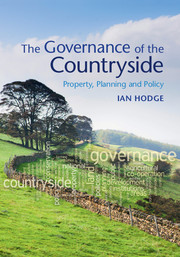Book contents
- Frontmatter
- Contents
- Preface
- Acknowledgements
- List of abbreviations
- Part I Introduction
- Part II Historical models
- Part III Governance under sectoral policies
- 6 Agricultural policies, farming and the environment
- 7 Land, development and planning
- 8 Protected Areas: the example of National Parks
- 9 Wildlife conservation: National Nature Reserves, Sites of Special Scientific Interest and Large-scale Conservation Areas
- 10 Public rights of way and access to the countryside
- 11 The control of agricultural pollution
- 12 The development of agri-environment policy
- Part IV Alternative approaches to governance
- Part V Conclusions
- References
- Index
12 - The development of agri-environment policy
from Part III - Governance under sectoral policies
Published online by Cambridge University Press: 05 February 2016
- Frontmatter
- Contents
- Preface
- Acknowledgements
- List of abbreviations
- Part I Introduction
- Part II Historical models
- Part III Governance under sectoral policies
- 6 Agricultural policies, farming and the environment
- 7 Land, development and planning
- 8 Protected Areas: the example of National Parks
- 9 Wildlife conservation: National Nature Reserves, Sites of Special Scientific Interest and Large-scale Conservation Areas
- 10 Public rights of way and access to the countryside
- 11 The control of agricultural pollution
- 12 The development of agri-environment policy
- Part IV Alternative approaches to governance
- Part V Conclusions
- References
- Index
Summary
But there may be a future in which agriculture will still be using most of Britain's land but doing so in a protective rather than an active role with the community choosing to forfeit maximum agricultural output in order to create a rural environment which provides for environmental rather than economic needs.
A.M. Edwards and G.P. Wibberley (1971) An Agricultural Land Budget for Britain 1965–2000. Studies in Rural Land Use No. 10. School of Rural Economics and Related Studies. Wye College, University of London (p. 112)Agri-environment policy has come to play a key role in the rhetoric of agricultural policy, even though it commands a more modest proportion of policy expenditure. This dates back to the mid 1980s, since when a series of agri-environment schemes have been introduced to pay farmers to manage the countryside in particular ways. In this chapter we consider the implementation and operation of agri-environment policy. While following common principles, schemes have differed between countries and here we concentrate on those implemented in England, particularly the Environmentally Sensitive Areas scheme, Countryside Stewardship scheme and, from 2005, Environmental Stewardship. The different schemes illustrate different aspects of the use of environmental contracts and we discuss their potential and limitations towards the end of the chapter. Yet, before we explain the schemes, we might wonder why government became involved in paying farmers to provide an attractive landscape in the first place. This is not something that government had ever attempted to do before, but it has become a major component of agricultural and rural policy. Annual expenditure on agri-environment policy in England currently exceeds £400 million. This is paralleled by the development of agri-environment schemes in other countries, especially across Europe, in the USA and in a growing number of other countries. See Uthes and Matzdorf (2013) and Hodge (2014) for recent reviews. Hanley et al. (2012b) have provided an overview of the economic principles behind incentivising landowners to provide biodiversity.
12.1 The origins of agri-environment policy
In Chapter 9, we discussed the implementation of management agreements on SSSIs following the 1981 Wildlife and Countryside Act. This addressed the problem of controlling agricultural intensification on notified sites of particular conservation value, but it failed to resolve the broader concern for the consequences of agricultural intensification in the wider countryside more generally where similar pressures for environmental damage were underway.
- Type
- Chapter
- Information
- The Governance of the CountrysideProperty, Planning and Policy, pp. 237 - 264Publisher: Cambridge University PressPrint publication year: 2016



